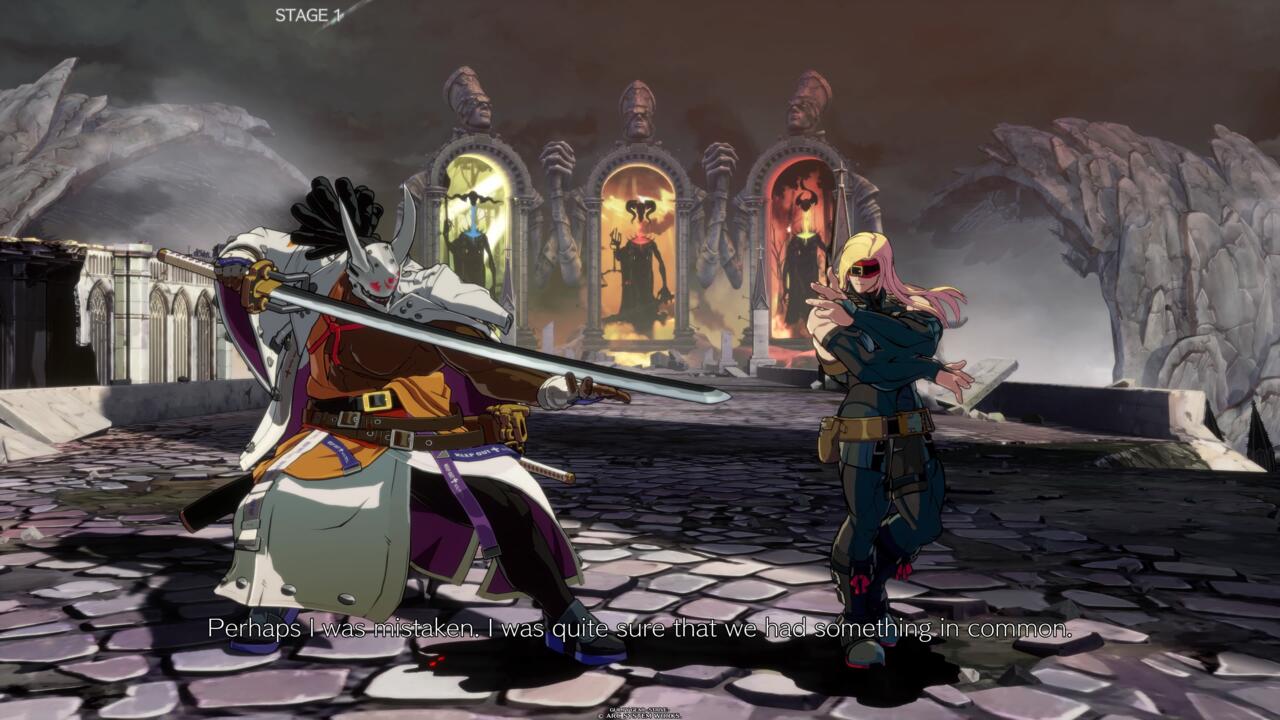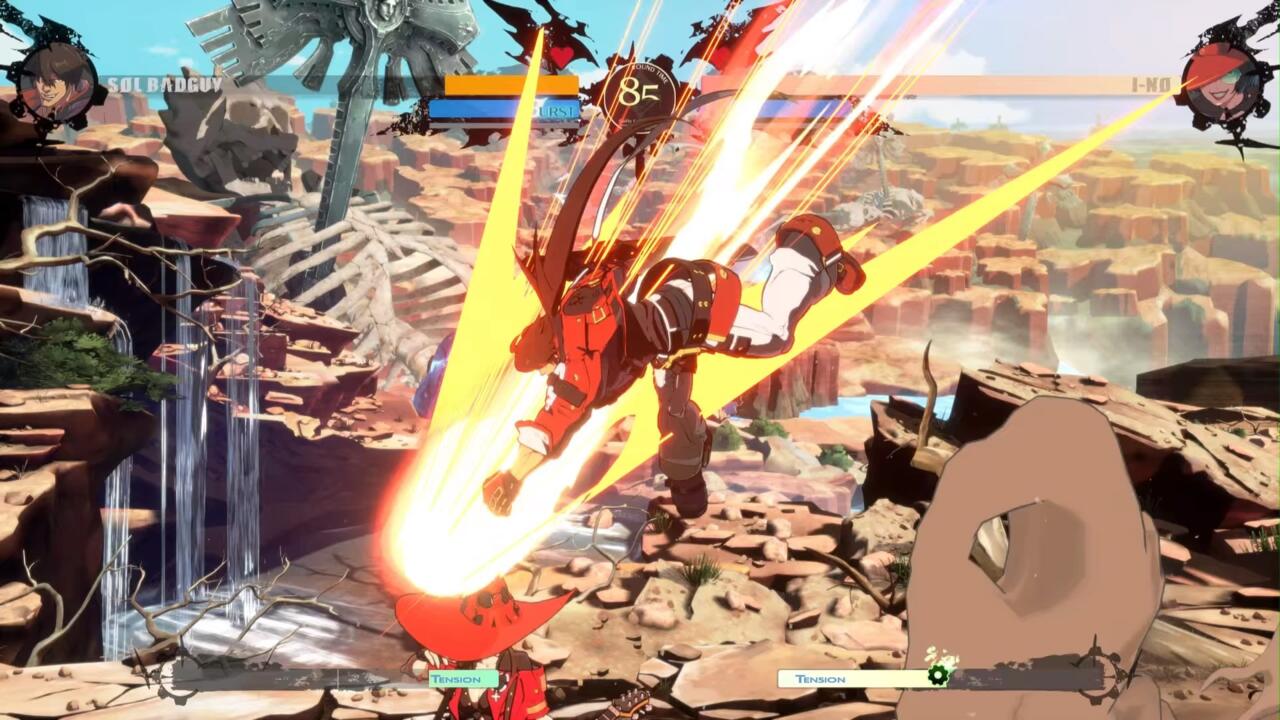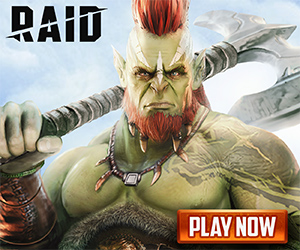Guilty Gear Strive is, like so many of its predecessors, the pinnacle of a certain kind of fighting game. The series, known for its highly technical (read: complicated) set of systems, rewards players for investing time to master both its universal systems and the nuances of its individual characters in a way that few other series have. Strive maintains that tradition and throws in a couple new ideas that bolster its bold anime-inspired flash without making the game any harder to learn. While the core fighting experience has only improved, many of the game’s less savory tendencies remain in place, including its non-playable story “mode” and yet another set of kludgy Arc System Works-style avatar-based matchmaking menus. As in most fighting games, those problems are secondary: Players, particularly veterans, who want to put in work will find Guilty Gear Strive to be a wild time.
If you’re counting, Strive is the eighth primary entry in the Guilty Gear franchise, so its fighting style is something of a known quantity. Strive retains many of the nuances of recent entries in the series. There’s the tension gauge, a special meter that increases when you attack or move towards your opponent and fills more slowly when you play defense. There’s faultless defense, a strategic extra block that trades tension to prevent chip damage and help you get some distance from an opponent. For a newcomer or casual player, Strive will feel just like a Street Fighter-style fighting game. Most special moves feature quarter-circles and charge motions, and thus may feel familiar at a glance, but there are many, many small nuances for you to learn in order to get the most out of its particular mechanics.
There are two major changes that longtime players will need to adjust to. Strive removes the “Gatling system,” a sort of hierarchy for canceling attacks to sustain combos, and changes the series’ signature “Roman Cancel” system, which allows you to trade half of the tension meter to cut short the animation before or after an attack to more quickly recover. I’ll be the first to admit that I’m not yet an expert on how to use these mechanics to great effect, but it seems that the combination of these two leads to more back-and-forth with shorter combos. I found that most of my fights, even against players way beyond my skill level, kept to a rapid tempo filled with short organic combos–flurries of light attacks anchored by a heavy or special. In theory, the Roman Cancel opens the door for high-level players to unlock longer strings with a precisely timed maneuver that keeps a combo from ending.
And yet, while the game is very technical, it also has a sense of spectacle, which feels universal. When one player hits the other to interrupt their attack, the word “COUNTER” flashes across the screen in giant letters. The last hit in each round triggers a brief cinematic shot to let you know the killing blow has been struck. Some of these ideas are evolutions of concepts from previous games, others are new. One new idea, the “wall break,” marries the technical and theatrical sides of the game very well. If one player manages to trap the other in the corner and land a few hits, they’ll send their opponent flying onto a new part of the stage. The wall break gets the player on the receiving end out of being trapped but, more importantly, it evokes this Dragon Ball Z-esque sense of scale when you punch someone off the screen.
If you need to learn any (or all) of these concepts, Strive has a deep set of tutorials called “mission” mode, which very briefly shows you how to use each and every one of its systems, plus lots and lots of general fighting game techniques. For better and worse, the lessons are constructed around building consistency: Each lesson asks you to do a technique five times. To complete it, you have to do it right at least three of them. As a lesson plan and testing system, it works great, but if you ever get stuck on a concept, you better go hit YouTube. And with some of the ideas, like Roman Canceling or certain character-specific abilities, more context is necessary to figure out what to do. In fairness, in-game teaching modes in fighting games widely suffer from these limitations, and Strive deserves credit for being very thorough.

For me, Guilty Gear’s characters have always been the thing that set it apart. As in the past, Strive’s roster creates a wide variety of approaches with very stylistic characters with movesets that allow them to control a fight in their own unique ways. From the haunting garbage-bag-wearing Faust, with his pull-and-push fishing rod, to Ramlethal Valentine, who’s followed around by two giant floating swords that she can throw around using specials, but need to be picked up to use again, temporarily limiting her range. The goal in making any fighting game character revolves around implementing a unique moveset that fits well with the others, but Guilty Gear has always excelled at giving characters personality through their unique combat styles.
Of the 15-character roster, there are only two newcomers in Strive, but both fit in and offer unique ways to play. Giovanna, an American secret service agent with her own wolf spirit, is a pure rushdown-style berserker, made to constantly apply pressure and get in their face. While the tension gauge, a special meter that increases based on forward movement and attacks, encourages aggressive play, Giovanna takes the all-gas-no-brakes approach to a new level. (At least among the Strive cast).
The other, Nagoriyuki, is a very strong vampire samurai with a giant sword that gives incredible reach, at the cost of limited mobility. Nagoriyuki moves and attacks very slowly, and doesn’t have a forward dash, but he does have a short-distance teleport as a special that can take its place. After using enough specials, though, he enters Blood Rage mode, which makes him stronger while draining his health. (Presumably, this forces you to use your dash deliberately). The checks and balances make Nagoriyuki incredibly appealing: For new players, he’s really fun to mess around with because he’s so powerful. For competitive players, his checks and balances add another layer of complexity to master. He’s an exemplar Guilty Gear character: Subtle changes to his character push you to use him differently than any other fighter.
…Players, particularly veterans, who want to put in work will find Guilty Gear Strive to be a wild time.
How the characters control is only half of it, though. The same inventive, varied design also applies to the character designs and the game’s overall look. From a rockstar witch to a giant World War One-inspired robot to, and I’ll say it again, a vampire samurai, the ideas are a rich and wild hodge-podge that somehow congeals into something completely unexpected, but remarkably cool. Strive’s anime-inspired 3D art brings each fight to life like you’re watching an epic action sequence in a movie.
Unfortunately, the actual Guilty Gear anime in Strive isn’t quite as captivating. Technically Strive has a story mode, but it’s actually just a long (maybe 3-4 hour) series of cutscenes–essentially, it’s a movie made using the game engine. I find this approach, which the series has used before, perplexing. While I recognize the narrative limitations that come up when you have to weave fights into a story, I think that having some gameplay is necessary. I generally don’t boot up a video game looking to watch a movie, especially not a fighting game.
In the other hand, divorcing the game from the story is probably for the best: There may not be an eight in the name, but the story trades on the years and years of plot built up over Guilty Gear’s history and expects you to have a working knowledge of its deep, complex lore to keep up. With a less than stellar grasp of that history, I enjoyed some of the intense and occasionally funny sequences, but got lost and tired in the long philosophical conversations that make up most of it. It’s a shame that the story will only appeal to the most hardcore of hardcore fans, because the story does bring some interesting depth to the characters that you won’t get anywhere else.

Last, but not least, we need to talk about how the multiplayer works. First, the good news: My experience playing Strive against other players was virtually flawless. I’m not going to tell you that I’m a great judge of netcode, but I know that Strive’s rollback-based netcode works incredibly well. The bad news: Strive uses yet another Arc System Works avatar-based matchmaking system, where you create a little character to move around and find players who are ready to fight. There’s a 10-tier lobby system, which seems to do a relatively good job of helping you find players with a similar skill level, but it can very easily backfire if there’s no one around in your particular level. Even when players are plentiful, though, finding matches takes longer than it should. Simply put, the system didn’t work before and it doesn’t work now.
The fighting in Guilty Gear Strive, though, is impeccable. And that’s what matters most. Like all Guilty Gears, it is a game of extremes. If you’ve tried the series and fallen off because of its complexities, I wouldn’t expect a different outcome. If you’re up for a challenge, or just want a cool, sharp-looking fighting game to mess around with, Strive knows all the right moves.











